1 min read
Remote Galaxies Appear Distorted and Fragmented

This NASA Hubble Space Telescope (HST) image of the central portion of a remote cluster of galaxies (CL 0939+4713) as it looked when the universe was two-thirds of its present age. Hubble's high resolution allows astronomers to study, for the first time, the shapes of galaxies as they were long ago.
The Space Telescope pictures are sharp enough to distinguish between various forms of spiral galaxies. Most of the spiral, or disk, galaxies have odd features, suggesting they were easily distorted within the environment of the rich cluster. Hubble reveals a number of mysterious "fragments" of galaxies interspersed through the cluster.
The HST picture confirms that billions of years ago, clusters of galaxies contained not only the types of galaxies dominating their descendant clusters today, but also several times as many spiral galaxies. These spiral galaxies have since disappeared through mergers and disruptions, as evident in the Hubble image.
This visible light image was taken with HST's Wide Field Planetary Camera 2 in Wide Field Camera mode, on January 10 and 12, 1994.
About the Object
- R.A. PositionR.A. PositionRight ascension – analogous to longitude – is one component of an object's position.09h 42m 56.59s
- Dec. PositionDec. PositionDeclination – analogous to latitude – is one component of an object's position.46° 59' 21.99"
- Object NameObject NameA name or catalog number that astronomers use to identify an astronomical object.CL 0939+4713
- Release DateDecember 6, 1994
- Science ReleaseObserves the Lost Ancestors to Our Milky Way Galaxy
- CreditCredit: Alan Dressier (Carnegie Institution) and NASA
Share
Details
Last Updated
Aug 17, 2025
Contact
Media
Claire Andreoli
NASA’s Goddard Space Flight Center
Greenbelt, Maryland
claire.andreoli@nasa.gov






























